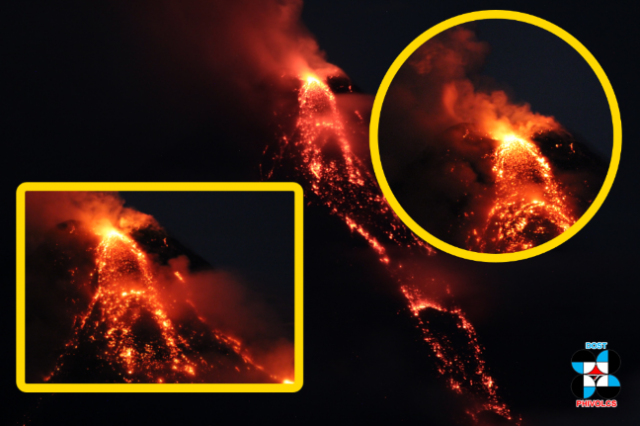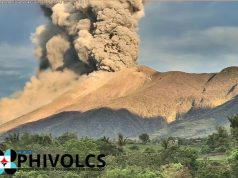
MANILA – Government scientists tracked overnight Mayon Volcano’s activity amid fears that day-long rains on Saturday could trigger lava flows that could swamp villages around the foot of the volcano, even as they continued to monitor two other active volcanoes: Kanlaon in Negros and Bulusan in Sorsogon.
In its 8am bulletin Sunday (Jan. 28) morning, the DOST’s Philippine Institute of Volcanology and Seismology (Phivolcs) reported that between 06:22 PM Saturday to 01:40 AM Sunday,”two episodes of sporadic lava fountaining from the summit crater lasting 23 minutes and 55 minutes occurred.”
Phivolcs said such events” fed lava flows on the Mi-isi and Bonga Gullies, sprayed near-vent lava spatter, and fed rockfall on the summit area. In between lava fountaining episodes, lava effusion continued to feed lava flows on the Bonga and Miisi Gullies. Heavy rainfall throughout the day generated sediment -laden streamflows in channels draining the volcano edifice.”
A total of four volcanic earthquakes, seven tremor events — two of which correspond to the lava fountaining events — as well as 23 rockfall events were recorded by Mayon’s seismic monitoring network, Phivolcs said.
“Rockfall events were generated by the collapsing lava front and margins of the advancing lava flow on the Bonga and Miisi Gullies. Currently, the Miisi and Bonga lava flows have maintained their advance to 3 and 1.8 kilometers, respectively, from the summit crater.”
Alert Level 4 remains in effect over Mayon Volcano, indicating imminent severe eruption, and Phivolcs strongly advised people to desist from entering the 8-kilometer-radius danger zone, and to be additionally vigilant against pyroclastic density currents, lahars and sediment-laden streamflows along channels draining Mayon.
Civil aviation authorities must also advise pilots to avoid flying close to the volcano’s summit as ash from any sudden eruption can be hazardous to aircraft, said DOST-PHIVOLCS.
KANLAON VOLCANO
Also in an 8am Sunday bulleting, Phivolcs said Kanlaon Volcano’s seismic monitoring network recorded five volcanic earthquakes during the past 24 hours. “Moderate emission of white steam-laden plumes that rose 500 meters from the summit before drifting southwest was observed during times when the crater is visible.”
Alert Level 2 prevails over Kanlaon Volcano, which means that the volcano is undergoing a moderate level of unrest, according to Phivolcs. “There is probable intrusion of magma at depth which may or may not lead to a magmatic eruption. The local government units and the public are strictly reminded that entry into the 4-kilometer radius Permanent Danger Zone (PDZ) is strictly prohibited due to the further possibilities of sudden and hazardous steam-driven or phreatic eruptions.”
Phivolcs said civil aviation authorities must also advise pilots to avoid flying close to the volcano’s summit because any sudden phreatic eruption can eject material hazardous to aircraft.
BULUSAN VOLCANO
Meanwhile, Bulusan Volcano’s seismic monitoring network did not detect any volcanic earthquake during the past 24 hours, Phivolcs said Sunday morning.
Alert Level 1 (abnormal) remains in effect over Bulusan Volcano, “which means that it is currently in a state of unrest probably driven by hydrothermal processes that could generate steam driven or phreatic eruptions.”
Local government units and the public were reminded that entry into the 4-kilometer radius Permanent Danger Zone (PDZ) is strictly prohibited and that vigilance in the Extended Danger Zone (EDZ) must be exercised due to the increased possibilities of sudden and hazardous phreatic eruptions. Likewise, civil aviation authorities were told to also advise pilots to avoid flying close to the volcano’s summit. People living within valleys and along river/stream channels especially on the southeast, southwest and northwest sector of Bulusan should be vigilant against sediment-laden stream flows and lahars in the event of heavy and prolonged rainfall, said DOST-PHIVOLCS.
READ ALSO: Phivolcs warns of possible lahar flows as heavy rains drench Albay









